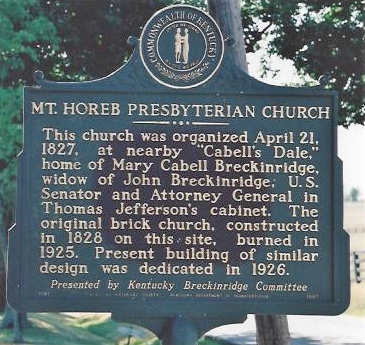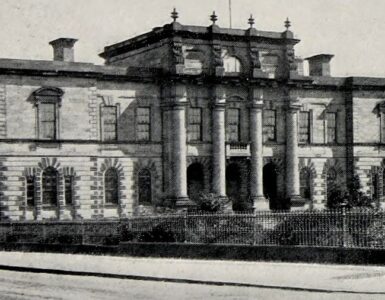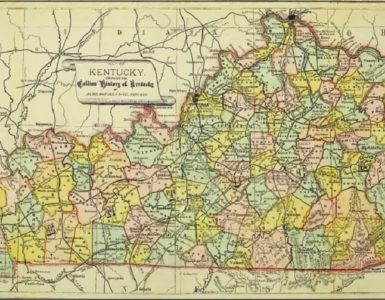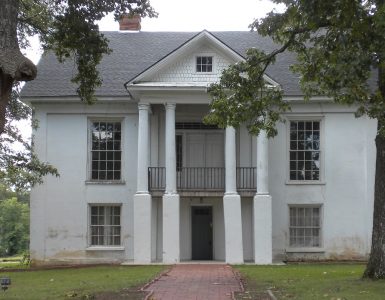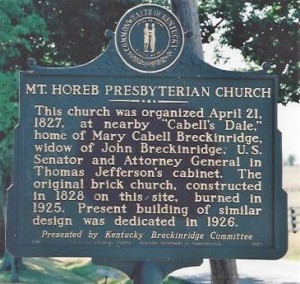 Just north of Lexington, Kentucky, heading east for about two miles from exit 120 of Interstate 75 along Ironworks Pike through the scenic bluegrass horse farms with their rail fences and white barns is located a stone building that is Mt. Horeb Presbyterian Church. Though not a large church building, those gathered for its organization in an earlier church on the site many years ago were important figures in the history of the American Presbyterian Church. Along side the road in front of the simple building is a State Historical Marker donated by the Kentucky Breckinridge Committee which reads:
Just north of Lexington, Kentucky, heading east for about two miles from exit 120 of Interstate 75 along Ironworks Pike through the scenic bluegrass horse farms with their rail fences and white barns is located a stone building that is Mt. Horeb Presbyterian Church. Though not a large church building, those gathered for its organization in an earlier church on the site many years ago were important figures in the history of the American Presbyterian Church. Along side the road in front of the simple building is a State Historical Marker donated by the Kentucky Breckinridge Committee which reads:
This church was organized April 21, 1827, at nearby “Cabell’s Dale,” home of Mary Cabell Breckinridge, widow of John Breckinridge, U.S. Senator and Attorney General in Thomas Jefferson’s cabinet. The original brick church, constructed in 1828 on this site, burned in 1925. The present building of similar design was dedicated in 1926.
Mary Cabell Breckinridge was also known as “Polly.” When her husband John died in 1806 she remembered him by wearing a black mourning hat for the remainder of her life which earned her the family nickname of “Grandma Black Cap.” In addition to Mary Cabell in the organizing congregation were Mary Clay Smith Breckinridge, Ann Sophonisba Preston Breckinridge, Sophia Rice Harrison, and the only male congregant and first elder of the small flock, William Lewis Breckinridge. Two of the Presbyterian clergy in the organization of the church enjoyed a Breckinridge-Cabell family connection, John Breckinridge and Joseph Cabell Harrison, but the third minister, Charles Phillips, appears not to have been a branch on the Breckinridge-Cabell family tree.
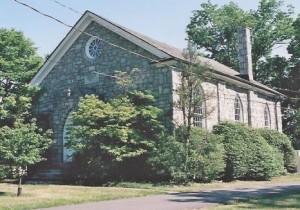 The first of the kin gathered at Cabell’s Dale was Mary Clay Smith Breckinridge who was Rev. John Witherspoon’s granddaughter by his daughter, Ann, who was married to the Presbyterian minister, Samuel Stanhope Smith. Witherspoon had been the president of Princeton College, 1768-1794, and his term was followed by that of his son in law, Smith, 1795-1812. Mary Clay’s presence for the church organization represented forty-four consecutive years of the Princeton College presidency. Mary Clay had married the first-born son of John and Mary Cabell Breckinridge, Joseph Cabell. As the oldest son, when his father died in 1806, he took charge of the management of the family estate. However, he was able to continue his studies and complete his college program at Princeton, which not only provided his education but also the opportunity to meet and marry Mary Clay Smith. Joseph Cabell did not become a Presbyterian minister like his three younger brothers, but as other Breckinridges of generations past and yet to come, he entered politics and represented his constituents in the Kentucky Legislature, and he served the state of Kentucky as its secretary of state. However, Joseph Cabell died a young man in his thirties in 1823 leaving Mary Clay a widow like her mother in law.
The first of the kin gathered at Cabell’s Dale was Mary Clay Smith Breckinridge who was Rev. John Witherspoon’s granddaughter by his daughter, Ann, who was married to the Presbyterian minister, Samuel Stanhope Smith. Witherspoon had been the president of Princeton College, 1768-1794, and his term was followed by that of his son in law, Smith, 1795-1812. Mary Clay’s presence for the church organization represented forty-four consecutive years of the Princeton College presidency. Mary Clay had married the first-born son of John and Mary Cabell Breckinridge, Joseph Cabell. As the oldest son, when his father died in 1806, he took charge of the management of the family estate. However, he was able to continue his studies and complete his college program at Princeton, which not only provided his education but also the opportunity to meet and marry Mary Clay Smith. Joseph Cabell did not become a Presbyterian minister like his three younger brothers, but as other Breckinridges of generations past and yet to come, he entered politics and represented his constituents in the Kentucky Legislature, and he served the state of Kentucky as its secretary of state. However, Joseph Cabell died a young man in his thirties in 1823 leaving Mary Clay a widow like her mother in law.
Ann Sophonisba Preston Breckinridge was the cousin and wife of Robert Jefferson Breckinridge. Robert Jefferson was the middle child of Mary Cabell’s three living sons. At the time of the founding of Mt. Horeb Church, Ann and Robert had been married for four years. Ann Sophonisba had been born in Washington County, Virginia, in 1803. Her father was General Francis Preston and her mother was the daughter of General William Campbell who commanded the victorious Revolutionary Army in the Battle of King’s Mountain. Ann Sophonisba professed her faith in Christ in 1824 before the congregation of the McChord Presbyterian Church in Lexington during the baptism of her and Robert’s first child. The service was led by the pastor of the church, who was her brother in law, John Breckinridge.
Sophia Rice Harrison was the wife of the organizing minister of the Mt. Horeb Church, Joseph Cabell Harrison. The “Rice” in Sophia’s name was her surname as the daughter of Rev. James Harvey Rice, who was the son of the father of Kentucky Presbyterianism, Rev. David Rice. David Rice had married the daughter of the Presbyterian minister, Samuel Blair. Blair was not only the pastor of a church in the countryside near Philadelphia, but he also operated a near by school that counted among its students Samuel Davies, who became a minister and president of Princeton College, John Rodgers, who was ordained to the ministry and became the moderator of the first General Assembly of the Presbyterian Church, and James Finley who was a pioneer Presbyterian minister in western Pennsylvania. Sophia Rice Harrison’s husband, Joseph Cabell, was a first cousin of the shortest termed President of the United States, William Henry Harrison, and he was connected to the Breckinridges as the nephew of Mary Cabell. In 1824, Joseph Cabell Harrison and his cousin, Rev. John Breckinridge, began publishing the first religious periodical in Kentucky, The Western Luminary.
It must have been quite a blessed occasion for Mary Cabell Breckinridge as she gathered with her family in her grand home at Cabell’s Dale for the purpose of organizing a new Presbyterian Church. In the case of two of her surviving sons, John and William Lewis, she could see God’s covenant faithfulness manifested in their Christian faith with one son a minister and the other son soon to be ordained. Her continued prayers for Robert Jefferson were to be answered, though not for a few years. Then there was her daughter in law who was a widow like herself, Mary Clay Smith Breckinridge, whose presence represented two Princeton College presidents that were Presbyterian ministers. Sophia Rice Harrison was the wife of Mary Cabell’s nephew and she represented the beginning of the Presbyterian Church in Kentucky as well as another president of Princeton College, Samuel Davies. Mary Cabell’s son John had married Margaret who was the daughter of Princeton Seminary Professor Samuel Miller, and John had taught in the seminary for a short time. Once Robert Jefferson became a Christian, he would study theology in preparation for the ministry with John’s father in law, Samuel Miller. The Breckinridges of Kentucky were woven into the history of American Presbyterianism especially via the several connections to Princeton’s College and Seminary. However, the greatest Breckinridge Presbyterian from Kentucky was yet to come as the grandson of Robert Jefferson and Sophonisba Preston, and his name would be Benjamin Breckinridge Warfield.
Barry Waugh
Notes—The pamphlet of Robert S. Sanders, Sketch of Mount Horeb Presbyterian Church 1827-1952, Commemorating the One-Hundredth and Twenty-Fifth Anniversary of Its Founding and the Thirtieth Anniversary of the Pastorate of Dr. Thomas Wallis Rainey, Lexington, Kentucky, June 15, 1952, Lexington: The Lexington Leader, 1953, was very helpful. The book by James C. Klotter, The Breckinridges of Kentucky, Lexington: University of Kentucky Press, 1986, 2006, and Bradley J. Gundlach’s, “‘B’ is for Breckinridge: Benjamin B. Warfield, His Maternal Kin, and Princeton Seminary,” in Gary L. W. Johnson, ed., B. B. Warfield: Essays on His Life and Thought, Phillipsburg: P&R, 2007, 13-53, explains the Breckinridge family tree. The above article is surely complex due to the similarity of and abundance of names. It is hoped that the intricacy of the content does not prohibit readers from completing this article about a truly remarkable family. In some cases, “Breckinridge” was left out of the writing of a name because it is clear from the context that the person is a Breckinridge. Mary Cabell Breckinridge’s full name is Mary Hopkins Cabell Breckinridge; the “Hopkins” was omitted to reduce the already dizzying assortment of names. When climbing the Breckinridge-Cabell family tree, there are many branches named “John,” “Joseph,” “Ann,” and “Mary” so be careful.


